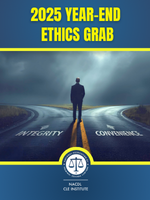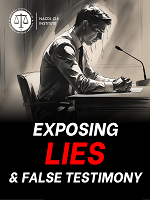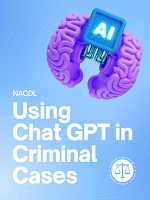Access to The Champion archive is one of many exclusive member benefits. It’s normally restricted to just NACDL members. However, this content, and others like it, is available to everyone in order to educate the public on why criminal justice reform is a necessity.
Within the next calendar year, the first group of Americans born in the 21st century will become adults. In their short lifetimes, they have witnessed the rise of social media, electric cars and 3D printing. In many ways, however, the criminal justice system in the United States is still stuck in the 19th century. The modern prison boom, with disproportionate representation and lengthier sentences for black citizens, would be very familiar to African Americans living in the post-Reconstruction South, where communities turned to incarceration to control and subjugate recently freed slaves.1 Elsewhere, the recent wave of voter ID laws and redistricting is reminiscent of Jim Crow efforts to exclude African Americans from the polls. Despite the many advances we will witness in the 21st century, the current criminal justice system ensures that many will not be present to take part: a third of black males born in 2001 will spend some part of their lives in prison.2
This startling figure should give every one of us pause. It represents not only a profound national failure, but a pathology that will unravel lives, families and the fabric of communities for generations to come. We must confront institutional racism embedded in the criminal justice system in order to prevent millions of Americans from watching the century unfold from behind bars. Communities of color face increased scrutiny from law enforcement in a climate that (falsely) presumes that they are more likely than whites to commit crimes. The following is just a glimpse into how the criminal justice system views black citizens:
- 42 percent of all school referrals to law enforcement are for black students, as opposed to 25 percent white and 29 percent Hispanic.3
- Black juveniles are more than four times as likely as their white peers to be committed to detention facilities.4
- Black drivers are two-and-a-half times more likely to have their cars searched during a traffic stop than white drivers.5
- People of color represent two-thirds of the life-sentenced population.6
- Despite using and selling drugs at rates similar to those of their white counterparts, African Americans and Latinos comprise 62 percent of those in state prisons for drug offenses.7
- In certain communities, the re-incarceration rate for African Americans is three times higher than that of whites.8
- Blacks in New York County (Manhattan) received plea offers with jail time in 74 percent of felony cases, while whites received plea offers with jail time in only 51 percent of felony cases.9
This uneven landscape is made worse by the fact that crime statistics simply do not support the added scrutiny and harassment. Several studies surrounding the War on Drugs, for instance, found that black citizens are less likely than their white peers to sell drugs.10 In New York, an analysis of the NYPD’s stop-and-frisk policy revealed that while black and Latino citizens were far more likely to be stopped by the police, white citizens were more likely to be carrying a weapon.11 Modern cellphone technology has placed the power to record and confront institutional racism into the hands of millions of Americans. Unsurprisingly, however, we are forced to confront institutional efforts to prevent citizens from recording police interactions.12 NACDL will be making contributions in this arena through the newly created Task Force on Sousveillance, co-chaired by Martin Sabelli and Chris Wellborn.
Videos of police encounters have started a national dialogue on the role race plays in the criminal justice system. Groups like Black Lives Matter and efforts such as Copwatch are responses, in a way, to how the system views citizens of color. They are helping to educate the public on the severity of racial issues in the criminal justice system and how far we have to go as a society. But education is needed on several levels. Policymakers must recognize that racism is systemic. Training on implicit bias should extend beyond law enforcement to the judiciary and all the other stakeholders in the justice system.13 Here, NACDL is playing a leadership role with the Presidential Summit, Race Matters, focused on confronting racism in the criminal justice system, to be held September 14-15 in Detroit.14
Once we collectively confront and educate decision makers about the pernicious racism in our system, we have the opportunity to change minds and change policy. In 2014, 12-year-old Tamir Rice was playing with a toy gun in a Cleveland park. Law enforcement was called, but the crucial observation that the gun was probably a toy was left out by dispatch. Within seconds of law enforcement’s arrival, Tamir was shot at close range. He died the next day. The officer who shot Tamir was subsequently fired, but for a discrepancy on his application form, not his actions in the park that day. While Tamir’s death has led to needed changes in how Cleveland trains its officers in de-escalation techniques, missing is the introspection into just what it was about a black child playing in a park that the police found so threatening as to open fire as a first option.15 An assumption of guilt has been allowed to replace a presumption of innocence in our communities of color. Two out of every three African Americans surveyed in a 2016 study of subjects between the ages of 18 and 30 said that they or someone they knew had been a victim of either police harassment or violence. That number shrinks to 30 percent for white subjects.16 Our assumptions about race must change. Fifty-nine percent of black people are jailed after felony arraignments as opposed to 41 percent of whites.17 Our assumption of pretrial detention must change to a presumption of release. Black men receive longer sentences than their white peers for similar offenses and black probationers are more likely to have their probation revoked than their white counterparts.18 Our assumption of incarceration must change to a presumption of rehabilitation.
I believe strongly in taking action to eradicate institutional racism and to move our system closer to its mandate. The statistics I cite above show a problem. What are we going to do about it? In an encouraging development, the millennials that will inherit our criminal justice system are currently leading many efforts at reform. Student protests at the University of Missouri — after students felt the school was not responding appropriately to incidents of prejudice on campus — led to the resignations of the president and the chancellor.19 Black Lives Matter developed a policy platform with specific goals across several themes, helping to solidify what started as a protest movement into a political force. This civic engagement is encouraging and fits the broader trends identified in a 2017 report by Achieve and the Case Foundation:
- “Millennials are showing significantly increased interest in causes that impact minority, marginalized or disenfranchised groups or people.”
- “Millennials are most interested in causes that promote equity, equality, and opportunity.”20
It is inspiring to see the next generation come together to fight injustice. At the same time, it should motivate the defense bar to rise up and make its own contributions. Each one of us must confront the disparities we witness in our own communities and courthouses, and work tirelessly to abolish them.
Notes
- Michelle Alexander, The New Jim Crow 32 (2010).
- U.S. Department of Justice, Bureau of Justice Statistics, available at https://www. bjs.gov/content/pub/pdf/piusp01.pdf.
- Department of Education, Office for Civil Rights (Mar. 12, 2012), available at https://www2.ed.gov/about/offices/list/ocr/docs/crdc-2012-data-summary.pdf.
- Joshua Rovner, The Sentencing Project, Racial Disparities in Youth Commitment and Arrests (Apr. 1 2016), available at http://www.sentencingproject.org/ publications/racial-disparities-in-youth-commitments-and-arrests.
- U.S. Department of Justice, Bureau of Justice Statistics, available at https://www. bjs.gov/content/pub/pdf/pbtss11.pdf.
- The Sentencing Project, Still Life: America’s Increasing Use of Life and Long-Term Sentences, available at http:// www.sentencingproject.org/wp-content/uploads/2017/05/Still-Life.pdf.
- E. Ann Carson & Daniela Golinelli, Bureau of Justice Statistics, Prisoners in 2012 — Advance Counts, Table 10 (July 2013), https://www.bjs.gov/content/pub/pdf/p12ac.pdf.
- J. Boulger, L. Bostwick & M. Powers, Illinois Criminal Justice Information Authority, Juvenile Recidivism in Illinois: Examining Re-Arrest and Re-Incarceration of Youth Committed for a Court Evaluation (2012).
- Besiki Luka Kutateladze & Nancy R. Andiloro, Vera Institute of Justice, Prosecution and Racial Justice in New York County — Technical Report (Jan. 31, 2014), available at https://www.ncjrs.gov/pdffiles1/nij/grants/247227.pdf.
- Jonathan Rothwell, The Brookings Institute, How the War on Drugs Damages Black Social Mobility (Sept. 30, 2014), available at https://www.brookings.edu/blog/social-mobility-memos/2014/09/30/how-the-war-on-drugs-damages-black-social-mobility; see also Robert W. Fairlie, Drug Dealing and Legitimate Self-Employment, 20(3) J. Labor Econ. (July 2002).
- New York Civil Liberties Union, Analysis Finds Racial Disparities, Ineffectiveness in NYPD Stop-and-Frisk Program; Links Tactic to Soaring Marijuana Arrest Rate (May 22, 2013), available at https://www.nyclu.org/en/press-releases/analysis-finds-racial-disparities-ineffectiveness-nypd-stop-and-frisk-program-links.
- Randy Peterson, Texas Public Policy Foundation Policy Perspective, Recording the Police (Apr. 2017), https://www.texaspolicy.com/library/doclib/2017-03-PP06-RecordingthePolice-CEJ-RandyPeterson. pdf.
- See https://www.americanbar.org/ publications/youraba/2016/september2016/strategies-on-implicit-bias-and-de-biasing-for-judges-and-lawyer.html.
- Go to www.nacdl.org/presidentialsummit for more information.
- Jacey Fortin & Jonah Bromwich, Cleveland Police Officer Who Shot Tamir Rice Is Fired, N.Y. Times (May 30, 2017), available at https://www.nytimes.com/2017/05/30/us/cleveland-police-tamir-rice.html?mcubz =0&_r=0.
- Black Youth Project at the University of Chicago, Results From a Nationally Representative Survey of Young People Age 18-30 Taken July 9-20, 2016, available at http://genforwardsurvey.com/assets/uploads/2016/11/GenForward-July-2016-Report-_-Final-copy.pdf.
- Kutateladze & Andiloro, supra note 9.
- Jess Jannetta et al., Urban Institute, Examining Racial and Ethnic Disparities in Probation Revocation (Apr. 2014), available at http://www.urban.org/sites/default/files /publication/22746/413174-Examining-Racial-and-Ethnic-Disparities-in-Probation-Revocation.PDF; see also William Rhodes et al., Bureau of Justice Statistics Working Paper Series, Federal Sentencing Disparity: 2005-2012 (Oct. 22, 2015), available at https://www.bjs.gov/content/pub/pdf/fsd0512.pdf.
- See https://www.theguardian.com /us-news/2015/nov/15/obama-university-of-missouri-protesters.
- See http://achievemulti.wpengine. com/mi/files/2017/06/Phase1Report_MIR2017_060217.pdf.
About the Author
Rick Jones is the executive director and a founding member of the Neighborhood Defender Service of Harlem, which has gained national and international recognition for its early-entry, holistic, client-centered, community-based, team-defense approach to public defense. He teaches the criminal defense externship and a trial practice course at Columbia Law School, serves on the faculty of the National Criminal Defense College in Macon, Georgia, and is a member of the board of the International Legal Foundation.
Rick Jones
Neighborhood Defender Service of Harlem
New York, NY
212-876-5500
www.ndsny.org
rjones@ndsny.org













